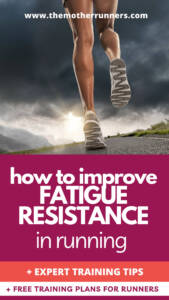Last December, I ran the California International Marathon. It was my first marathon in 3 years after a 2.5 year break from running due to injuries. I was fit and ready. But my legs weren’t. They quit at mile 16. The reason was initially unclear—but I soon realized it was because I lacked fatigue resistance in running.
Related: The California International Marathon: A Review
What is fatigue resistance?

Fatigue resistance in running is essentially how long your legs can run at a faster pace without tiring.
Fatigue resistance (or fatigue tolerance) is something I’ve always struggled with since I haven’t had the opportunity to stack training cycle upon training cycle due to things like pregnancies, childbirth, illness, and injury.
Related: How I Stopped Being an Injury-Prone Runner
My experience with fatigue resistance in running races
When my legs stopped working during my marathon, I wasn’t sure what happened. I had a flawless build back. I ran PRs in the half marathon and the mile leading up to my marathon. All my workouts indicated I would run a PR.
Indeed, I was on pace to run a 2:50 marathon when over the course of about 3 miles, my legs got increasingly tired. Then they just stopped turning over. My nutrition was on-point. The weather was perfect. What was happening?
After the marathon, I did research, talked with runner friends, had a call with exercise physiologist Todd Buckingham. The results were in. I lacked fatigue resistance.
Fatigue resistance takes time to develop. Indeed, it can take two to three years to optimal train fatigue resistance in runners. It made sense that I lacked it after such a long running hiatus,
Related: The Benefits of the Long Run for All Runners
How I knew I lacked fatigue resistance

Reflecting on my training, I realized the evidence was there that I didn’t have strong fatigue resistance in my legs. The one workout I could never nail was my pick-ups on my long runs. Pick-ups are when you run the last several miles at a faster than easy pace or goal marathon pace.
And I struggled. I could never hit them. And they felt HARD when the pace should have felt only moderately hard. I couldn’t get my legs to move fast and the effort taxed my aerobic system.
In fact, for all the marathons I’ve ever done, I struggled on all my long run pick-ups and my legs stopped working well before mile 20 in the marathon.
So, how could I fix it? Is time training the only solution to improving fatigue resistance in runners?
Fortunately, no. There are training techniques you can use to improve fatigue resistance in running. I am sharing what helped me improve my fatigue resistance in just one marathon cycle.
Related: How to Increase Mileage Safely
In this article, I will cover:
- How do marathon runners not fatigue quickly?
- How does fatigue affect runners?
- What does lack of fatigue resistance feel like?
- How do you know if you lack fatigue resistance?
- The basics of improving fatigue resistance, and
- 4 effective ways to improve fatigue resistance in runners
Let’s go!
Why marathon runners are not fatigued quickly?
Marathon runners don’t fatigue quickly because their bodies become efficiently at processing fuel for energy to power their working muscles. The more running you do, the more physiological adaptations are spurred to use energy without wasting it.
Your bones, muscles, and soft tissues also become stronger so they tire less easily.
Finally, stocking up carbohydrates during the marathon taper and fueling with them throughout the race gives the body fuel to keep running.
Related: How to Carbo-load Before Your Marathon
How does fatigue affect runners?
As runners get tired, it becomes harder to move your legs and “run tall.” Our running cadence, stride length, and hip and knee extension are reduced. Some runners will experience stomach or muscle cramping.
Related: 9 Running Hacks That Make You Run Faster
What does lack of fatigue resistance feel like?
A lack of fatigue resistance feels like stiff legs that don’t want to move. It is different than feeling a muscle cramp. It just feels like your legs are heavy and immobile, and it is a lot of effort to turn them over.
Different than bonking, a lack of fatigue resistance is really only felt in the legs. The rest of your body including your stomach and alertness feel fine. Your legs just don’t want to move.
How do you know if you lack fatigue resistance?
If you’ve experienced stiff, heavy legs while running long distances, then it’s likely you need to improve your fatigue resistance.
How long does it take to improve fatigue resistance?
Research suggests you will see an improvement in fatigue tolerance in just six weeks—though it can take two to three years of consistent training to reach the optimal of your fatigue tolerance.
How can I improve my fatigue resistance when running?
You can improve your fatigue resistance when running by safely and intentionally getting your legs used to running tired. See the below strategies to help adapt your training to “callous” your legs.
Related: Strength Training Guide for Runners
10 basics of improving fatigue resistance

Improving fatigue resistance in runners will happen naturally as long as runners are consistent in their training and dotting the I’s and crossing the T’s.
Truly, the secret to the sauce of improving fatigue resistance is getting your body used to running—and then getting your legs used to running when they are tired. And then, giving them what they need to work and recover well.
Studies show that the best way to improve fatigue resistance is to focus on volume and higher intensities on tired legs.
Here are the basics to improve fatigue resistance in runners:
Related: How to Change Your Running Form
- Run consistently at least three to four times a week.
- Include one longer run that is at least 30 percent of your overall weekly volume. For experienced and/or advanced marathon runners, it is really helpful to have several long runs over 20 miles in a training cycle.
- Fuel your runs properly. Be sure to eat about 200 calories of simple carbs pre-run. Take a gel every 30 minutes on runs longer than an hour. And refuel within 30 minutes after your longer runs.
- Increase your volume by about 10 percent each week.
- Strength train. Lifting weights before your run or right after your run may improve fatigue tolerance in runners.
- Running hills as a regular designated hill workout or during hill strides after a run can improve fatigue resistance in runners.
- For more advanced runners, running “doubles” can improve fatigue tolerance. This means you would run a hard workout in the morning and then later in the day, run a few easy “shake-out miles.” You can also cross-train as a double which is a better option for injury-prone runners.
- Get used to running on tired legs. That means doing a run the day before your long run, or especially the day after your long run. So if you ran 20+ miles on Saturday. You could do an easy 5 mile run on Sunday.
- Recover properly. Be sure you are eating and sleeping well, and running easy on easy days to prevent overtraining.
- Shortening recovery time. Shortening recovery time between intervals or adding a “float” in between work bouts instead of a standing interval rest can also help improve fatigue tolerance. A float is easy to moderately hard running.
Related: Running on Tired Legs: Cumulative Fatigue Explained
4 Effective Ways to Improve Fatigue Resistance in Runners
In my marathon training cycle before the Carmel Marathon in 2023, my fatigue resistance greatly improved. Even if I didn’t set a marathon PR, I deemed this marathon cycle a success in improving my fitness with the sheer fact that it took longer for my legs to tire.
This was most evident in my long run pick-ups. I was able to run 10 miles at the end of a 23-mile run at a pace I couldn’t hold for a single mile in a long run pick-up just months before.
Here are the 4 changes to my training that I believe greatly improved my fatigue tolerance.
1. Run more volume.
On a mid-week long run, I had a very eye-opening conversation with my friend (who has run at the Olympic Trials Marathon). She said, “Whitney, there’s no way you are going to run a sub 2:50-marathon on 65 miles a week. You need to run more.”
She was right.
Coming off of a cycle of running injuries, I was scared to run more. I needed to feel secure in my mileage before building more. However, after having a healthy training cycle, I felt comfortable to up the ante a bit in this training cycle.
I began adding easy miles to my warm-ups, cool-downs, mid-week long run, and on my recovery day (Sunday). I hit 80 miles 3 non-consecutive weeks in my 16-week marathon training cycle. The rest of the weeks beyond base phase, down weeks, and taper were in the mid to high 70s.
I believe running more helped in getting my legs used to running more miles, especially when tired.
In adding running volume, you need to be careful in how you do so:

- The extra miles need to be run a true easy pace that feels comfortable and controlled.
- You also should only increase about 10-20 percent from one marathon training cycle to the next.
- Finally, ensure you include down weeks (a slight reduction in mileage) about every 3-4 weeks to help your body absorb the training and prevent injuries.
Related: How Running Strides Makes You Faster
2. Run after your long run.
One of the biggest changes to my training this marathon cycle was adding another day of running. For me, that was a 7th day of running (7 days of running is only recommended for experienced runners).
After returning to running after my injuries, I strongly adhered to a Sunday rest day. It was crucial in keeping me healthy. After successfully completing a healthy marathon cycle, I began to do an easy hour of cross-training on the elliptical on Sundays after my Saturday long run.
After a month of this, I substituted a 5-7-mile easy run on Sundays after my long run.
Adding this very easy recovery run helped get my legs used to running when tired and learning how to process oxygen when fatigued. This can mimic what they need to do when running a marathon. Your body needs to know how to keep accessing and using oxygen when tired. Recovery runs after long runs help you do this while at the same time building those mitochondria and capillaries.
The key to these post-long run recovery runs is running them VERY easy (slow) and not forcing them. If your body doesn’t loosen up after a couple of miles, then take it on home.
They will feel difficult at first, but over time your body will become more accustomed to doing these recovery runs. And voila, you will have improved your fatigue resistance.
Related: The Benefits of an Easy Running Pace
3. Run longer cool-downs.
Another change in my training that has improved my fatigue resistance is running longer cool-downs. Again, this gets the body used to running on tired legs. After a workout, I began running a 3-mile cooldown instead of a 2-mile cooldown.
How Many Miles Should I Run in a Day?
This extra mile is an opportunity for your body to figure out how to work when it’s tired and supply energy to working muscles. It’s just an extra 10 minutes or so of your time but pays dividends in improving fatigue tolerance.
4. Do longer long run pick-ups.
Finally, I did longer pace work in my long runs. Since I knew my long run pick-ups were my kryptonite, it made sense to tackle the problem head on my adding in more work into my long runs.
First, I began running my long runs at a little bit of a faster pace. Last marathon cycle, I ran my long runs very easy as “time on feet.” Eventually, I could run forever at an easy pace but when I ran faster, that is when my legs got tired. So, I increased my easy pace a bit to callous my legs more.
Then, my coach and I extended my pick-ups—first beginning with a moderate pick-up at the end of my long runs, e.g. 4 miles at 30-seconds faster than easy pace.
About every other week, we would add distance to the pick-ups as well as effort. My peak long run had me running 10 miles at about 10 seconds faster than marathon pace.
Including these longer efforts earlier in my training helped me immensely physically and mentally. My legs became used to running fast when they were tired at the end of a long run. And mentally, I wasn’t scared of the work anymore. Programming the workouts as “30 seconds faster than easy” or in “heart rate zone 4” took the stress away from hitting certain paces to start.
Once I built fatigue tolerance (and confidence), I was able to dial in and hit specific paces. This was a huge mental boost heading into race day knowing I could complete 10 miles at a faster than marathon pace at the end of a long run.
Related: How to Predict Your Marathon Pace
Train from where you are
It’s important to note that a runner should work up to these training adaptations. My first marathon cycle laid the groundwork for this kind of training. In this marathon cycle, I was able to turn up the dial first starting with workouts based on effort which prepped my body to then do it based on specific paces.
Successful training meets your body where it’s at. You cannot force fitness. If you try, you will get injured. If you’re looking to improve fatigue resistance in running, then you need to begin with running consistently and carefully introducing more volume and intensity. A running coach can help you do that if you aren’t sure how to safely or you feel like you’ve plateaued.
If you want guidance with your run training, including strength training, check out my run coaching services. Also, be sure to check out my free training plans:
